The Story Of One Of The 91st SRS COs.
|
|||||||||||||||
| Shortly after our return to Travis, I received orders to process for an unaccompanied one year PCS (Permanent Change of Station) tour to Japan. I was to become the Commanding Officer of the 91st Strategic Reconnaissance Squadron based at Yokota AFB,. How lucky can it get. Two straight tours in the best job any Air Force officer can hope for – Squadron Commander! I processed over the Christmas holiday, relocated my family into a new rental in Vacaville, CA and flew to Japan via MATS. Upon signing in at Yokota, I relieved Ltc Vince Crane as CO. To my amazement, I found that there were nine Lieutenant Colonels in the squadron that out-ranked me. However, I was, by direction of the President, the CO. I also found that I was the only person in the squadron that belonged to Strategic Air Command. |
|||||||||||||||
 |
|||||||||||||||
 |
|||||||||||||||
|
Photo Ctsy. Robert F. Dorr |
Photo Ctsy. Chuck Stone |
||||||||||||||
|
The squadron consisted of some 12 RB-29s (The WWII designation of F-13 had long been changed to RB-29), 4 RB-45s ( North American 4 jet engines) and a flight of 4 SAC RB-50s that were temporary duty planes and crews from Biggs AFB, TX. Captain Hammersmith was flight commander of the RB-50s which had the same fuselage as the RB-29s but a larger engine and electric propellers. They were used strictly for electronic reconnaissance with special high level permission, mostly on classified missions into and on the periphery of China and Russia. Lt. Col. Len Kauffman was flight commander of the RB-45s. Each RB-45 had a different equipment configuration. Because of their speed were used for photo and electronic reconnaissance to keep track of the North Koreans and also, with special high level DOD (Department of Defense) permission, were used on classified missions into and on the periphery of China and Russia. The RB-29s also had many configurations. They were used in many different roles of mapping, photo and electronic reconnaissance and voice intercept missions.
|
|||||||||||||||
| Shortly after I arrived, Ltc Ted Seith, a West Point graduate, was promoted to full colonel. He was immediately reassigned within FEAF (Far East Air Force). He later became the Commandant of Cadets at the Air Force Academy and retired as a Lieutenant General. I met with all of the Lieutenant Colonels who out-ranked me, explained the situation and I got along fine with all of them during my tour. My squadron operations office, Major Bob Kleyla, who later went to CIA, was a jewel. I also had a top notch 1st Sergeant, Msgt D. W. Eltzroth, who played a key role in keeping the work of the 91st on time and on track. |
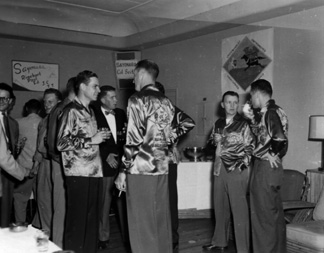 |
||||||||||||||
|
Below, left: M/Sgt. D. W. Eltzroth, at his desk. |
|||||||||||||||
| My superiors, because of my relatively short tour as the 91st CO (it turned out to be only nine months), had determined that I would not be cleared for some of the higher than top secret security clearances. Thus, I was not privy to sit in on many of the briefings nor permitted to fly on the highly classified missions. I had the highest respect for all of the flight and maintenance crews assigned the squadron. Some, were ”retreads” like myself who had been recalled to active duty at the start of the Korean War. Some were young career officers and airmen. A few were older career officers and airmen. Aside from the TDY RB-50 crews and me, married officers and airmen had their families living on base. My flying was limited to photo mapping and reconnaissance over South Korea. |
|||||||||||||||
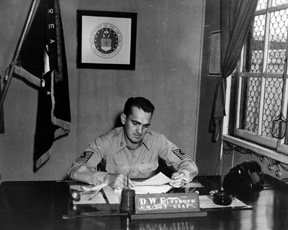 |
|||||||||||||||
 |
|||||||||||||||
|
Left: Lt. Col. Becker pins an award on one of the 91st SRS crew members (not identified). |
|||||||||||||||
| Although the Korean War was over, FEAF Bomber Command still had bases in Japan. There were B-29 Wings at Yokota and Kadena, AFB on Okinawa. As the 91st CO, I was privileged to attend Major General Joseph Caldera’s Wing Commanders meetings at Yokota and a General Earl Partridge’s FEAF Commanders Conference in Tokyo. My fondest memory of a meeting in Tokyo is General Partridge’s comments upon his return from Vietnam. President Eisenhower had tasked him to take a staff group to Saigon, meet with the French and make recommendations as to US involvement. It was at the time that the French were in trouble at Dien-Bien-Phu. The General said that the French were concerned about the situation at Dien-Bien-Phu, but not enough to do anything about it! He added that the French use of its air power left much to be desired.. If they had 10 bombs, they would put one bomb on each of 10 targets doing little damage to any of them. He said that his recommendation to the President was for the US to stay out of the mess there. Oh, if that advice had only been followed, I wonder how different our world might have been! Life at Yokota was pleasant. I only wish that I had been able to have my family with me and be closer to the aircrews flying some very exciting missions. When I left Yokota, in October, I was the last SAC commander. The squadron became a fully FEAF owned and operated unit with the exception of the TDY RB-50s.When my orders to return to the states came, I read that I was assigned to 15th Air Force Hq at M arch AFB, CA |
|||||||||||||||
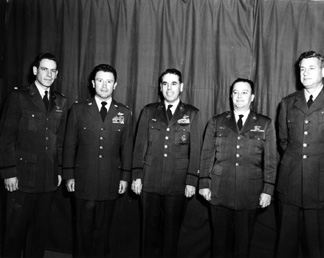 |
|||||||||||||||
|
|
|||||||||||||||
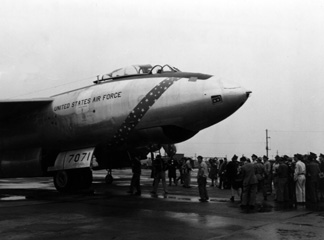 |
|||||||||||||||
|
In the Spring of 1954, SAC 15th AF Commander, |
|||||||||||||||
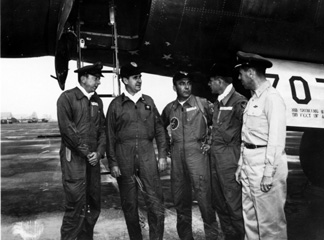 |
|||||||||||||||
|
1 — 2 — 3 — 4 — 5 — 6 — 7 — 8 — 9 — 10 — 11 Cover Page — Introduction — Table of Contents Or you may go to Home - Contact Us - Cold War Hist. - 91st SRS Hist. - Stardust 40 Mission Story |
|||||||||||||||